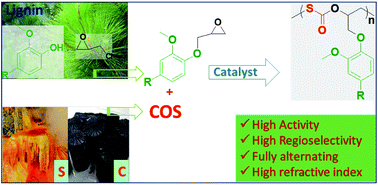Alternating and regioregular copolymers with high refractive index from COS and biomass-derived epoxides†
Abstract
This study describes the catalytic formation of alternating and regioregular copolymers from carbonyl sulfide (COS) and epoxides along with eugenol-based glycidyl ether (EGE) and guaiacol-based glycidyl ether (GGE), derived from eugenol and guaiacol, respectively. The (salen)CrCl [salen = N,N′-bis(salicylidene) cyclohexanediimine] complex, accompanied with various organic bases, was highly active towards the EGE/COS, GGE/COS copolymerization and EGE/GGE/COS terpolymerization. The turnover of frequency (TOF) of the (salen)CrCl complex for the EGE/COS copolymerization was up to 12 000 h−1. The number-average molecular weight (Mn) of the resultant EGE/COS copolymer was up to 62.2 kg mol−1. In the presence of 0.5–1.5 mol% chlorohydrin, which was a by-product of the synthetic process of EGE, α-Cl, ω-OH EGE/COS copolymers were obtained. This result suggests that chlorohydrin could act as a very efficient chain transfer agent for the copolymerization. The EGE/COS, GGE/COS, and EGE/GGE/COS copolymers were soluble in most of the common solvents and exhibited a high refractive index of more than 1.58 with high Abbe numbers of up to 40.4. This study provides an unprecedented and sustainable synthetic route for making soluble sulfur-rich polymers with high optical properties.



 Please wait while we load your content...
Please wait while we load your content...